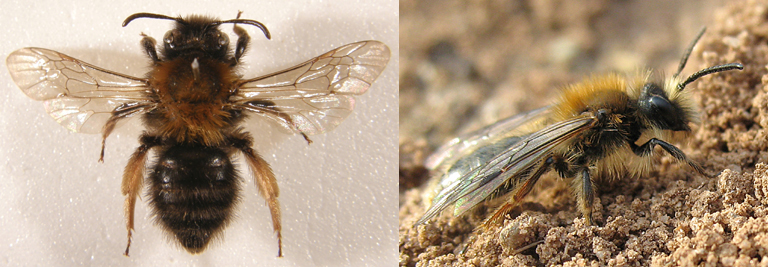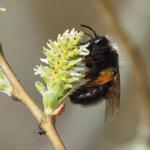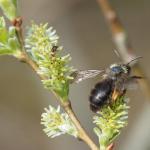Andrena tricolor Imhoff, 1832; Andrena dispar Zetterstedt, 1838; Andrena polita Schenck, 1861.
This is often the first solitary species of bee to be found in the spring, sometimes flying in mid February. As with many of the early spring bees, A. clarkella forages almost exclusively from sallow blossom.
Local but very widely distributed throughout the British Isles. In Britain the range extends north to East Inverness. In Ireland it is widespread across central areas. Also recorded from the Isle of Man and the Channel Islands. This bee is Holarctic. In Europe, it occurs mainly in the north, from Swedish Lapland and northern Finland east to Russia, and in Turkey. In North America it is found from Alaska to Ontario and south to Colorado.
This species is not regarded as being scarce or threatened.

The female (above left) is a robust, medium sized mining bee. Fresh specimens are quite distinctive and with experience can be recognised in the field. Almost always found on sallow (Salix) flowers in early spring. The face (clypeus) has dense black hairs across its entire width. The thorax has dense, deep reddish-orange hairs across the dorsal surface. The abdomen has dense black hair, particularly on tergites 1 and 2. The hind tibia and basitarsus are yellowish-orange but this colour can often be obscured by pollen collected on the hind legs. (Photo: Steven Falk)
Similar species: Larger specimens of female A. bicolor Fabricius may be taken for this species, but A. bicolor has dark hind tibia and basitarsus.
The male (above right) is less distinctive, particularly so in older specimens. Very fresh specimens exhibit quite bright orange hair across the top of the thorax, with pale golden hairs on the sides of the thorax, with at least a few black hairs amongst these pale golden hairs. The posterior margin of the gena is almost right angled. Inexperienced students should restrict records to females. (Photo: Nigel Jones)
Open woodland, heaths, moors and disused sand and gravel pits.
Univoltine; mid February to the end of May. The winter is passed as a freshly emerged adult in its sealed natal cell (Box, 1919; G R Else, pers. obs.).
Nests, which are excavated in the soil, occur either in small clusters (e.g. between the buttress roots of a large tree) or in extensive, dense aggregations on level and sloping ground. Nests have also been discovered in the soil attached to the root-plate of a fallen tree (G R Else, pers. obs.). In woodland, males have a very distinctive flight, zig-zagging up a tree trunk, flying off to a neighbouring tree and repeating the same behaviour. This would seem to be a mate-locating strategy, as females have been observed at rest on trunks, perhaps awaiting the arrival of males. Males also fly low over nesting aggregations.
In addition to the above species this bee has been reported to visit colt's-foot (Tussilago farfara) and dandelion (Taraxacum sp.) flowers, these two plants probably being only nectar sources. Males of this species are rarely encountered on flowers of any kind. In the former Czechoslovakia, males have been recorded flying to hazel (Corylus avellana) catkins in the absence of other flowers (Kocourek, 1966).
The bee Nomada leucophthalma (Kirby) is a well-known cleptoparasite of this Andrena. Perkins (1919) and Parmenter (Oldroyd, 1969) found puparia of the bee-fly Bombylius minor Linnaeus in nests of A. clarkella. This might be a misidentification of B. major Linnaeus, as B. minor flies only in the summer, not in the early spring. The stylopid Stylops transversus affects A. clarkella in Belgium (Kinzelbach, 1971) and may do so in Britain, though stylopised specimens of this bee are rarely found in this country.
2001
Identification notes added 2011 by Nigel Jones



